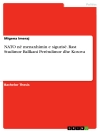This book begins with an account of the evolution of improvised explosive devices using a number of micro case studies to explore how and why actors have initiated IED campaigns; how new and old technologies and expertise have been exploited and how ethical barriers to IED development and deployment have been dealt with. It proceeds to bring the evidence from the case studies together to identify themes and trends in IED development, before looking at what can realistically be done to mitigate the threat of IEDs in the new wars of the twenty first century. The book suggests that the advance and availability of a combination of technological factors, in conjunction with changes in the nature of contemporary conflicts, have led to the emergence of IEDs as the paradigmatic weapons of new wars. However their prevalence in contemporary and future conflicts is not inevitable, but rather depends on the willingness of multiple sets of actors at different levels to build a web of preventative measures to mitigate – if not eradicate – IED development and deployment.
Inhaltsverzeichnis
Introduction.- Chapter 1. From the Gunpowder Revolution to Dynamite Terrorism.- Chapter 2. Dynamite Terrorism and the Fin de siècle.- Chapter 3. IEDs in the Twentieth Century.- Chapter 4. IEDs in ‘New Wars’.- Chapter 5. The Diffusion and Adoption of IED technology.- Chapter 6. Strategic Governance of IEDs.- Conclusions.IED Futures from past.
Über den Autor
James Revill is Research Fellow with the Harvard Sussex Program, SPRU, University of Sussex, UK. Revill has worked as a consultant to the United Nations Institute for Disarmament Research and completed research fellowships with the Landau Network Centro Volta in Italy and the Bradford Disarmament Research Centre in the UK. Revill’s research interests focus on interplay between science and security.












